Early ripening cucumbers "Zyatek F1" with high yield and excellent disease resistance
Not a single summer cottage can do without cucumbers. Therefore, I want to choose a variety or hybrid that will satisfy all the needs of gardeners - both fruitful and aesthetic. The Zyatek f1 hybrid fascinated many with its simple agricultural technique, with a yield of up to 13 kg per square meter, excellent taste and an easy-to-pickle form.
Read about its advantages and nuances of cultivation, as well as how to get the maximum yield, in our article.
The content of the article
Characteristics and description of cucumber
The hybrid of the first generation Zyatek f1 is the result of the joint work of the Moscow Research Institute of Vegetable Growing and the Gavrish agricultural company.
Recommended for breeding under a film cover, in greenhouse conditions and open ground.
Distinctive features
The culture belongs to the parthenocarpic type, that is, pollination occurs without the help of insects. According to many farmers, bee-pollinated varieties are superior to others in terms of taste, but parthenocarpic plants have their own advantages: the fruits do not outgrow, do not overripe and do not coarse. Also, such cucumbers are not prone to yellowing, they retain a rich green color for a long time.
The photo shows the cucumber Zyatek.
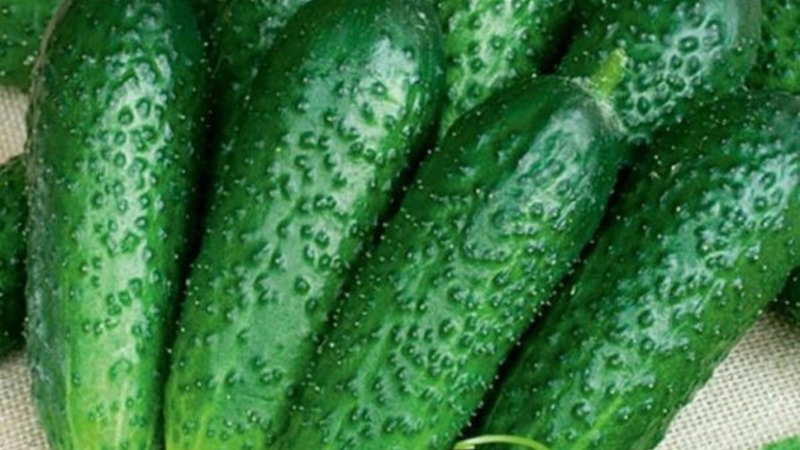
Composition, benefits, calories
The beneficial composition of cucumbers is known through numerous scientific studies. The structured water contained in cucumber has a beneficial effect on the kidneys, helps to remove excess salts and toxins from the body. The useful composition is complemented by such trace elements as: magnesium, potassium, zinc, iron, silver. Also, the vegetable is rich in vitamins A, C, PP, group B and others.
reference! Potassium is vital for the proper functioning of the heart and blood vessels.
The pulp and peel contains soft fiber, which is necessary for intestinal motility and the elimination of toxins.
The calorie content per 100 g of the product does not exceed 15 kcal. This indicator allows you to use vegetables in your diet.
Cucumber-based cosmetic masks are especially effective after sunburn. The skin becomes more elastic, tightened, and thanks to the light whitening effect, it becomes noticeably brighter. Fresh cucumber juice contains vitamins A and E.
Plant characteristic
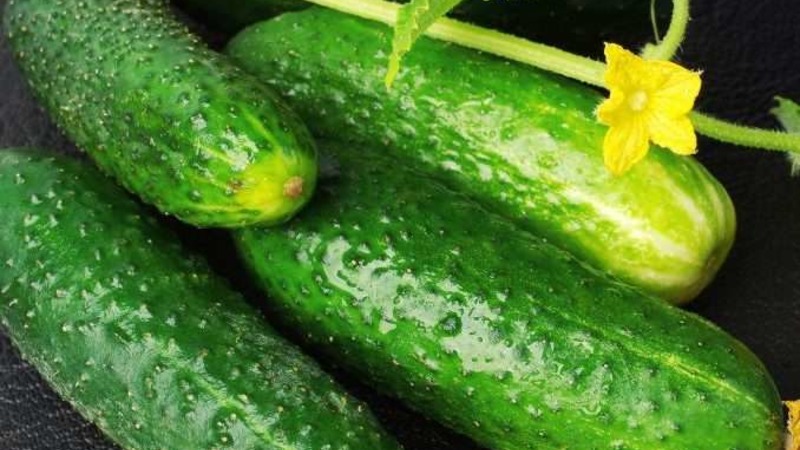
The type is indeterminate, that is, without limitation in growth, the branching is average, the root system is powerful. Several ovaries are simultaneously formed in one node. The flowering type is female, so there are practically no barren flowers.
Zyatek is an early ripe hybrid, 42-48 days pass from the moment of germination to full maturation.
The yield is high - from 1 sq. m, up to 13 kg of excellent fruits are harvested, provided that 2-4 seedlings are planted per 1 sq. m. Fruiting is long-term, during the entire growing season.
The culture is characterized by increased resistance to diseases such as powdery mildew, root rot and peronospora (downy mildew).
Well adapted to adverse weather conditions and stressful situations. A stressful situation for a cucumber can be created by: poor-quality watering, a sharp jump in air temperature, poor-quality soil or prolonged contact with direct sunlight.
reference! When stressed, cucumbers release a substance called cucurbitacin, which makes the vegetable flesh bitter.
Fruit characteristics
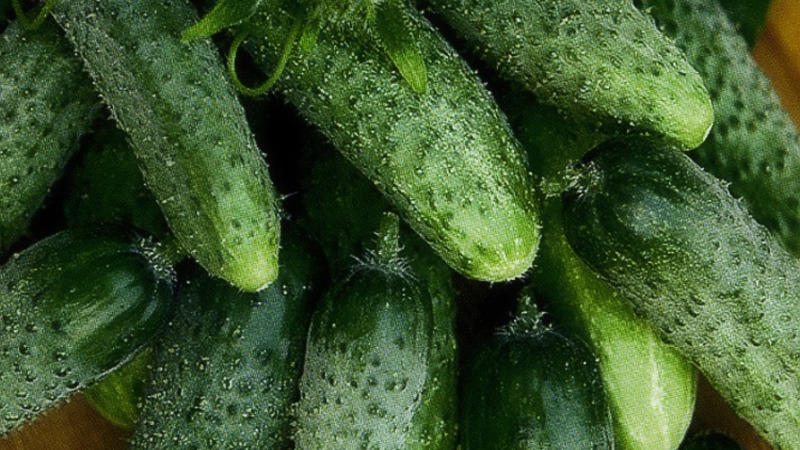
The average weight of a cucumber is 90-100 g, length - 10-12 cm, cylindrical shape, elongated. The color is rich dark green with short light stripes, dense pubescence. The taste is without bitterness, the pulp is juicy, crispy, without bitterness, the seeds are tender, small, the rind is thin but firm.
The presentation is perfectly combined with taste, therefore vegetables are in high demand in the markets. They are bred on an industrial scale and sold anywhere in the country.
The use of ripe cucumbers is universal. They perfectly complement fresh dishes and do not lose their taste in any winter preparations.
How to grow a hybrid yourself
Most farmers know that it is impractical to collect seeds from hybrid crops for sowing on their own, since the result will differ from the qualities declared by the manufacturer. The seed stock of hybrids does not retain the parental properties of varieties in subsequent generations.
Cultivation of Zyatek cucumbers is possible both in the open field and through seedlings. Let's take a closer look at these two methods.
Sowing seeds in the ground
By buying seeds from well-known producers, farmers are guaranteed to receive high-quality seeds. Such seeds have already been disinfected and impregnated with a layer of nutrients necessary at the initial stage of development. In short, the purchased grains are ready for planting.
For the full growth and development of culture, light, non-acidic soil is needed. Increased acidity is indicated by the appearance of plants such as plantain, buttercup or sorrel. In this case, slaked lime or dolomite flour should be added to the soil.
Before sowing, the soil is dug up with the introduction of humus. The distance between the holes and between the rows is left 50 cm. The seeds are sown to a depth of 1.5-2 cm, moistened with warm settled water and covered with foil until shoots appear.

Sowing seeds for seedlings and further care
Proper planting and care of the seedlings lead to further healthy growth. Sowing seeds begins 25-30 days before transplanting to a permanent place. Due to the vulnerable root system, disposable containers are chosen, pre-disinfecting them with a dark solution of manganese. At the bottom of the planting containers, small drainage holes must be made to drain excess moisture. Its stagnation is detrimental to young roots.
The soil is prepared from garden soil mixed with peat and washed river sand. River sand is added for lightness, and peat saturates the soil with additional nutrients. The finished mixture is spilled with a hot solution of potassium permanganate for disinfection purposes. The cooled soil is poured into the planting containers, filling them by one third. As the seedlings grow, the remaining soil is poured into containers. Thus, throughout the entire seedling period, the seedlings receive additional nutrition.
reference! The soil purchased in a specialized store does not need disinfection. It is sold ready for sowing.
The seeds are sown to a depth of 1.5-2 cm, moistened with warm, settled water and covered with a film to accelerate the emergence of seedlings. The containers are left indoors at a temperature of 22-25 ° C.
When seedlings appear, the containers are rearranged on the windowsill in order to eliminate the lack of natural light. Otherwise, the sprouts will begin to stretch, weakening the main stem.
Water the seedlings as needed with warm, settled water from a shallow watering can. After watering, the soil is superficially loosened. In the middle of the seedling period, they are fed with liquid complex fertilizer for cucumbers.
A week before transplanting, the seedlings should be hardened, bringing the living conditions as close as possible to the street ones. For this, the seedlings are taken out into the open air (but not into a draft) in the daytime at a temperature of at least + 18 ° C.
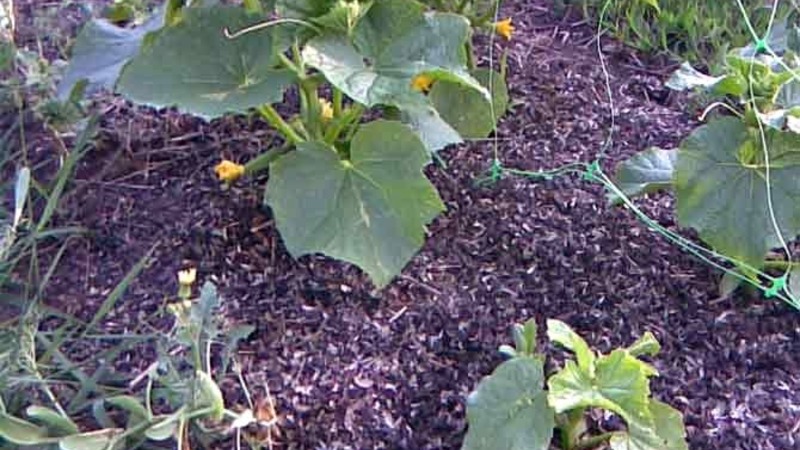
Transfer
The soil is prepared a week before transplanting. It is dug up and humus is introduced. Shallow holes are filled with peat by a third and filled with warm water.
Planting scheme - 50x50 cm.With this placement, each plant receives enough heat and light. For 1 sq. m no more than four seedlings are planted.
Cucumber care Zyatek
Water the culture with warm water at least three times a week. It is important to keep the soil moist and not dry out completely. For this, the beds are mulched with peat or straw.
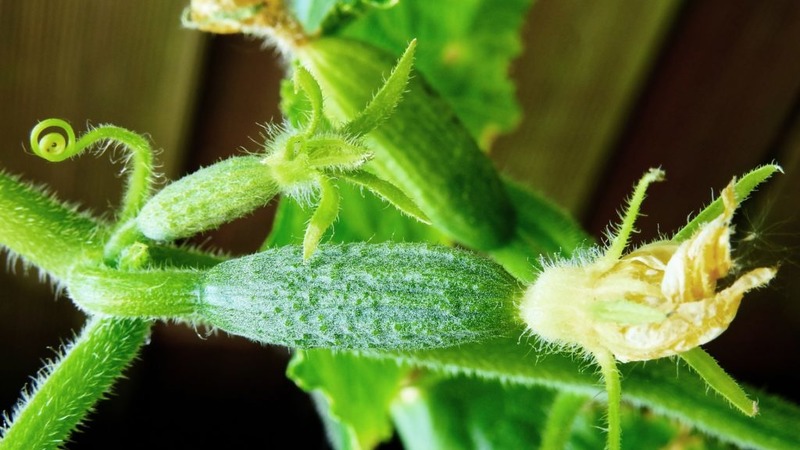
reference! It is not worth pouring over the beds, since an excess of moisture threatens the spread of fungal infections and rotting of the roots.
Loosening is carried out carefully, because the roots are close to the surface and are easy to damage.
Do not forget about timely weeding. Weed grasses take many nutrients from the ground that are necessary for the development of crops. In addition, weeds are carriers of diseases that are dangerous for plants of the pumpkin family.
During the entire growing season, the culture is fed four times: two weeks after transplanting, during the flowering period and twice during the fruiting period.
The first dressing consists of a full range of minerals, with an emphasis on phosphorus and nitrogen. The second time (during the flowering period) the plant needs organic matter. Fertilize with infusion of mullein in a ratio of 1:15.
At the time of fruit ripening, potassium salts and phosphorus are added. The fourth top dressing is carried out two weeks later to prolong fruiting. During this period, wood ash is added to the top dressing. All dressings are combined with the evening watering.
Some features in care
The indeterminate type of plant requires a garter, and this hybrid is no exception. Installing the trellis will not create any particular difficulties. To do this, you need to install metal supports on different sides of the garden bed and stretch a wire horizontally between them. A mesh is attached to the wire, to which the stem and branches of the plants are tied.
To increase the yield, the formation of seedlings is carried out... They are formed into one stem, regularly removing all other lateral processes. As soon as the top reaches the top of the trellis net, it is pinched, thereby limiting further growth.

Diseases and pests
Since the genes of the hybrid are immune to the main diseases of the Solanaceae family, the observance of preventive measures will be quite enough to keep the plant healthy throughout the growing season. Spraying with an infusion of garlic, nettle or onion husks will protect plantings from fungal infections. Also, the preventive function is performed by: moderate and regular watering, loosening, weeding and daily ventilation of closed structures.
Aphids are dangerous for the leaves because they bite through the leaf plate and drink the juice, as a result of which the plant dies. To combat aphids, use a soap solution (1 piece of laundry soap is dissolved in a bucket of warm water).
reference! Aphid - a small insect of yellow or black color.
Another pest is spiderweb mite... He, like aphids, feeds on plant sap. A favorite habitat is hotbeds, as the tick loves warmth. Therefore, it is enough to ventilate closed structures on a daily basis in order to destroy its habitat. In case of a large accumulation of spider mites, Fitoverm is used.
Harvesting and application of the crop
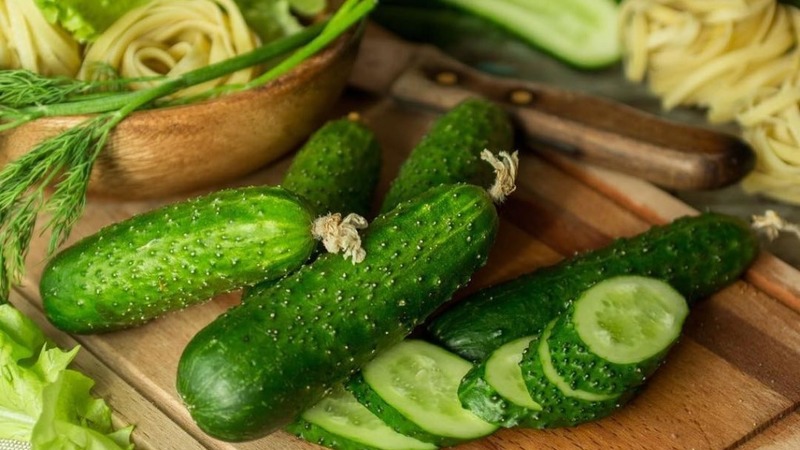
Harvesting begins in early July. With additional feeding during fruiting, the ripening period of the fruit becomes longer.
Cucumber variety Zyatek is also grown on an industrial scale. Ripe vegetables retain their presentation for a long time and tolerate transportation well.
Cucumbers are used universally in cooking. They are ideally combined with any vegetables in fresh dishes and do not lose their taste in pickles and marinades.
Advantages and disadvantages of a hybrid
The many advantages of culture attract the attention of many gardeners.
Here are the most basic benefits:
- two breeding methods: seedling and direct planting in the ground;
- uncomplicated agricultural technology;
- persistent immunity to diseases;
- high productivity;
- great fruit taste;
- long-term fruiting;
- marketable condition;
- long transportation;
- fast implementation;
- universal application.
The negative qualities include the garter of the plant and the formation of a bush.
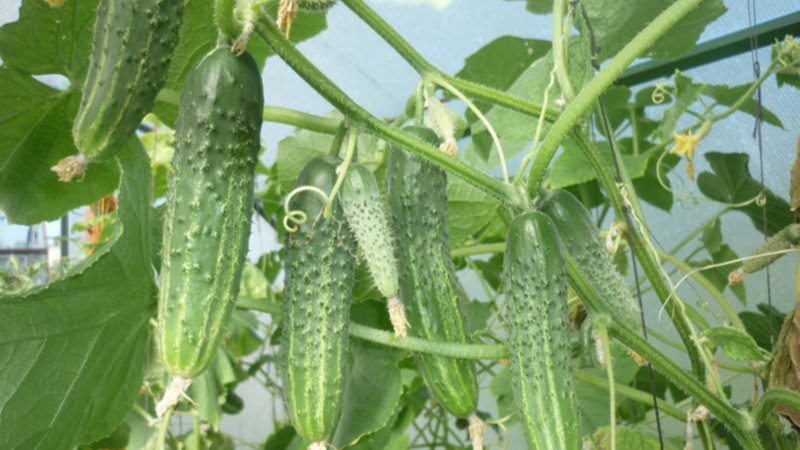
Reviews
Positive reviews indicate that the culture is trustworthy and does not require increased attention. Here are the opinions from those who planted Zyatek cucumbers:
Anna, Stavropol: “I recommend my beloved Son-in-law to everyone! I really like these cucumbers. Juicy, crispy, small seeds, the skin is tender and does not taste bitter. The harvest is always excellent, cucumbers ripen quickly. For conservation I collect while they are still small, like gherkins. Such robust people in pickles remain crisp and fit more tightly into jars. "
Bogdan, Kazan: “The cucumbers are pleasant to the taste, all even, of the same size, beautiful green color, lumpy and spiky. It is easy to care for a hybrid, it does not get sick. I grow for sale and always earn money. I advise everyone. "
Conclusion
Cucumbers Zyatek f1 - a treasure for summer residents. This hybrid is resistant to many diseases, very easy to care for and with an excellent rate of fruiting (up to 13 kg per 1 sq. M).
The high demand in the sales markets makes it possible to breed crops on an industrial scale, earning considerable income. And versatility in cooking allows you to cook salads and winter preparations from cucumbers.